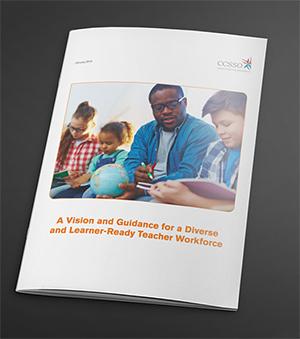“I’ve never had a teacher that looks like me before.”
“She heard a peer call her a dirty Mexican and then she painfully watched as her teacher turned a deaf ear.”
“As a biracial/African American teacher, I was faced with a group of white students whose parents would prefer them not be taught by someone of color.”
These are the real experiences of educators and students captured in a new report by the Council of Chief State School Officers, created in partnership with the AFT and 29 other education advocates. The report, “A Vision and Guidance for a Diverse and Learner-Ready Teacher Workforce,” is a call to improve diversity for students and educators in our public schools, and the unlikely partnership—union members with state superintendents and school administrators—amplifies the pressing need to improve school experiences for all students and educators, but especially for people of color.
It also underscores the AFT’s commitment to safe and welcoming schools for everyone, regardless of a student’s ethnicity, race or gender. Research shows that students of color significantly improve their academic performance when they have a teacher who reflects their own racial or cultural background; one study found that students were 39 percent less likely to drop out of school if they had at least one black teacher in grades 3-5. Yet, while 51 percent of public school students are students of color, just 20 percent of their teachers are people of color.
The report outlines specific steps to not only recruit and retain more educators of color but also ensure that teachers of all backgrounds are culturally responsive to the diverse students in their classrooms. “Students benefit from mirrors and windows; the mirror representing the story that reflects their own culture and helps them build their own identity, and the window that offers them a view into someone else’s experience,” the report reads. “Simply stated, diversity makes us smarter.”
AFT members are already working to diversify the education workforce with “grow your own” teacher training programs and initiatives for people of color to enter and remain in education professions. From contract language that requires that schools be intentional about diversifying the workforce (Chicago Teachers Union), to scholarships for paraprofessionals attending education courses (Saint Paul Federation of Teachers) and programs for career and technical education students to teach their trade (United Federation of Teachers), the AFT is committed at every level to advancing diversity in schools.
The goals of these programs dovetail with the vision CCSSO outlines in its report: to create an inclusive environment and a school culture that embraces social and emotional learning, a diverse group of supportive teacher peers who have the time and resources to collaborate, professional-level salaries and opportunities for career advancement.
To get there, the AFT and more than 30 other CCSSO partners will use the report to advocate for specific improvements, sharing these and other proposals with state legislatures, district policymakers and others who can shape the school experiences moving forward. Among the proposals are:
- Licensure standards that ensure a culturally responsive teacher workforce.
- Investment in multiple (affordable) pathways into teaching.
- Rigorous teacher prep program standards for recruiting candidates from diverse backgrounds and training all candidates in culturally responsive practices.
- Accountability mechanisms that track and report statistics on diversity in education.
- Federal funding for workforce diversity initiatives.
CCSSO declares that state education agencies “can and must collaborate with relevant stakeholder groups” to achieve these goals. Teacher voice, through the AFT, is paramount.
[Virginia Myers]

